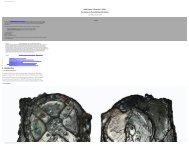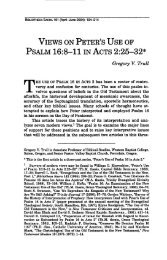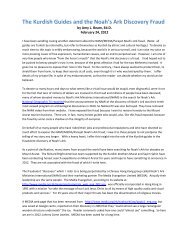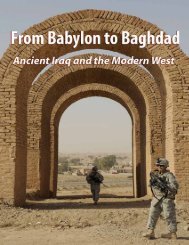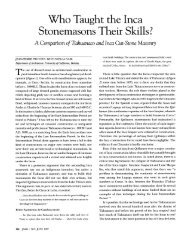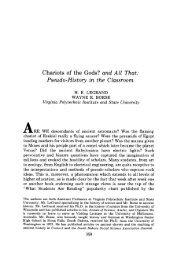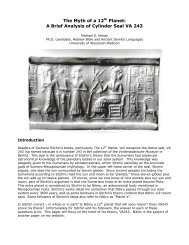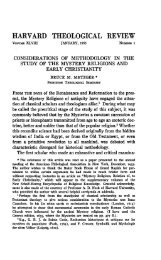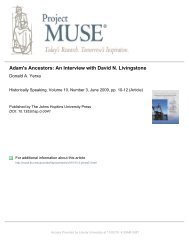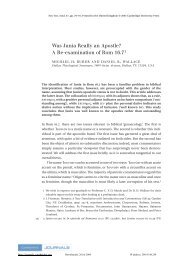ABRAHAM AND THE MERCHANTS OF URA P ... - Michael S. Heiser
ABRAHAM AND THE MERCHANTS OF URA P ... - Michael S. Heiser
ABRAHAM AND THE MERCHANTS OF URA P ... - Michael S. Heiser
You also want an ePaper? Increase the reach of your titles
YUMPU automatically turns print PDFs into web optimized ePapers that Google loves.
<strong>ABRAHAM</strong> <strong>AND</strong> <strong>THE</strong> <strong>MERCHANTS</strong> <strong>OF</strong> <strong>URA</strong><br />
P R<strong>OF</strong>ESSOR Jean Nougayrol has pub-<br />
lished an important corpus of<br />
Akkadian tablets from the south<br />
archives of Ugarit, under the title Le<br />
Palais royal d'Ugarit, IV, Textes ac-<br />
cadiens des archives sud (Archives inter-<br />
nationales) (Paris: Imprimerie nationale,<br />
1956) (abbreviated PRU, IV). Most of<br />
these documents were sent to Ugarit from<br />
other places including Hattusa, the<br />
Hittite capital.<br />
On pp. 103-5 of PRU, IV there is a<br />
tablet (17.130) from Hattusili III (reigned<br />
ca. 1282-1250 B.c.) to Niqmepac,l King of<br />
Ugarit, regulating the status and activi-<br />
ties of Hattusili's merchants who were<br />
conducting business in Ugarit. The mer-<br />
chants of the Hittite King come from the<br />
city of Ura; in line 6 they are called<br />
mdrmelr zu-ra awtlume tamkdra, "mer-<br />
chant men,2 citizens of the city of Ura."<br />
Ura was a city whose men specialized in<br />
tamkdrutum, "foreign trade," the metier of<br />
the tamkdrum, "merchant." (For other<br />
tablets mentioning the many merchants<br />
of Ura, see PRU, IV, 190, 203, 256.)<br />
Niqmepac had lodged complaints to<br />
Hattusili against the Ura merchants<br />
operating in Ugarit (PRU, IV, 103, 1. 7).<br />
1 The succession of the Ugaritic kings is full of<br />
problems. I have shown (Antiquity, XXIX [19551,<br />
147-49) that we may have to reckon with dyarchy<br />
(double kingship) at Ugarit, perhaps in the manner<br />
of Sparta. When Niqmad writes to Niqmepac as a<br />
complete equal (ahu, "brother"), dispensing with the<br />
royal titles of sender and addressee (text 17.315,<br />
PR U, IV, 111) such as kings of different nations use<br />
when writing to each other, we need not assume with<br />
Nougayrol that this Niqmad must be a king of some<br />
other realm writing to King Niqmepac of Ugarit.<br />
They may well be simultaneously ruling kings of<br />
Ugarit: one residing in the capital, while the other<br />
attends to affairs elsewhere. If dyarchy was practiced<br />
at Ugarit, it will affect the chronology.<br />
CYRUS H. GORDON<br />
28<br />
Accordingly Hattusili regulated their<br />
activities as follows: The Ura merchants<br />
could ply their trade in Ugarit only dur-<br />
ing the summer (literally i-na e-bu-ri, "in<br />
the harvest"). Since most people could<br />
pay only when the crops had produced<br />
"cash," the season for profitable trading<br />
was more or less confined to the summer<br />
anyway. During the winter (i-na uimitimiti<br />
ku-us-si, "in the days of cold": 11. 13-<br />
14), the merchants of Ura had to clear out<br />
of Ugarit and return to their own land.<br />
This kept the merchants on the move and<br />
prevented them from exploiting unduly<br />
their theaters of operation. Moreover<br />
Hattusili decreed that the Ura merchants<br />
were not to buy Ugaritic real estate<br />
(bttdti^ eqldtimel). (That all real estate<br />
may have been considered royal domain<br />
in Ugarit is hinted in line 33 where the<br />
term "real estate" is expressly defined as<br />
sa sar mdtu-ga-ri-it, "belonging to the<br />
King of Ugarit.'3 On the other hand, the<br />
King of Ugarit was not to prevent the<br />
merchants of Ura from seizing the persons<br />
(together with the wives and children) of<br />
Ugaritic debtors who could not repay the<br />
merchants (11. 25-31).<br />
This tablet reflects a number of social<br />
phenomena of significance for an under-<br />
standing of the ancient Near East. First,<br />
strong rulers controlled a class of semi-<br />
official merchants who were allowed to<br />
2 Many of the so-called determinatives in cunei-<br />
form are often meant to be pronounced. That this is<br />
the case with awtlufme is indicated not only by the<br />
mes-sign, but also from parallel usage such as 'andAm<br />
'ahtm "andhnfi (Gen. 13:8; called to my attention<br />
by Mr. Svi Rin).<br />
3 Lev. 25:23-34 forbids the sale of real estate in<br />
Israel except urban dwellings (vs. 30) in non-Levitical<br />
(vs. 32) walled cities.
<strong>ABRAHAM</strong> <strong>AND</strong> <strong>THE</strong> <strong>MERCHANTS</strong> <strong>OF</strong> <strong>URA</strong><br />
conduct business in vassal or weaker king-<br />
doms.4 In periods of more or less stable<br />
international relations, tamkdrutum was<br />
controlled. One of the means of prevent-<br />
ing excessive exploitation was to keep the<br />
merchants on the move. We also see that<br />
there were pressures to prevent the mer-<br />
chants from acquiring real estate (and this<br />
incidentally reflects the merchants' desire<br />
to buy land).<br />
The above evidence throws new light<br />
on the patriarchal narratives of Genesis.<br />
For some strange reason, little if any at-<br />
tention has been paid to the repeated<br />
statement in Genesis that the patriarchs<br />
were in Palestine for trading. Joseph is<br />
represented as telling his brethren that if<br />
they can establish the fact that they are<br />
bona fide and honest, they may trade<br />
(V/shr) in the land (Gen. 42:34). We<br />
may assume that Joseph is depicted as<br />
knowing the occupational pursuits of his<br />
own family. The trading interests of the<br />
patriarchs are confirmed by Gen. 34:10,<br />
where the Shechemites invite Jacob's<br />
household to unite with them: "And with<br />
us you may dwell and the land shall be<br />
before you; dwell and trade (V/sir)<br />
therein, and acquire real estate in it."<br />
This passage brings out three basic fea-<br />
tures of the tamkdru in the document of<br />
Hattusili cited above. (1) The patriarchs,<br />
like the merchants of Ura, went abroad to<br />
do business. (2) Settling down in a foreign<br />
area of opportunity would normally be<br />
pleasing to men who were regularly kept<br />
on the move (indeed Hebrew s6her, "mer-<br />
chant," means literally "one who turns<br />
hither and yon"). And (3) acquiring real<br />
estate in the land of their activity was a<br />
chronic wish of the merchants that was<br />
generally denied to them.<br />
4 Thus when Damascus was in the ascendant,<br />
Damascene merchants operated in Samaria; but<br />
when Ahab defeated Ben-Hadad, the situation was<br />
reversed, and Israelite merchants were admitted to<br />
Damascus (I Kings 20:34).<br />
29<br />
These considerations put Genesis,<br />
chapter 23 in new perspective. The emphasis<br />
on Abraham's purchase of the cave<br />
of Machpelah from Ephron the Hittite, in<br />
the presence of the Hittite enclave at<br />
Hebron, reflects the unusual character of<br />
the transaction. It was no routine affair<br />
for a merchant to acquire real estate<br />
abroad. The mercantile background<br />
seems also to be reflected in the expression<br />
describing the 400 shekels of silver that<br />
Abraham paid to Ephron; it is called<br />
C6ver las-soher (vs. 16).<br />
The sale of Machpelah follows Hittite<br />
law5 and was transacted before a Hittite<br />
community. How much of a hold the<br />
Hittite Empire had on Hebron at that<br />
time is hard to say. Probably the proximity<br />
to Egypt made of Palestiiie a sort of<br />
no-man's land where both the Egyptians<br />
and Hittites tolerated each other's commercial<br />
enterprise. In the north, around<br />
Ugarit, the King in Hattusa regulated the<br />
activities of his merchants with a firm<br />
hand. In Palestine his merchants would<br />
have a freer hand but would have to provide<br />
for their own security. Abraham may<br />
have been tempted to'ply his trade as far<br />
south as Palestine for the freedom of opportunity<br />
he thereby gained. At the same<br />
time he had to secure the interests of his<br />
household and of his kinsmen by maintaining<br />
his own militia and by forming<br />
alliances with local Amorite chieftains<br />
(Gen. 14:13-14, 24).<br />
The fact that the patriarchs wandered<br />
and owned flocks6 has beclouded our<br />
6 M. F. Lehmann, Bulletin of the American Schools<br />
of Oriental Research, No. 129 (Feb. 1953), pp. 15-18.<br />
6 Not only village farmers but even city folk in the<br />
Near East often own cattle. This has been the case<br />
from remote antiquity to the present day. One of the<br />
familiar scenes that impress the tourist in the Near<br />
East is the flocks being counted as they return within<br />
the city walls for the night. Hammurapi's Code takes<br />
no notice of nomadism, but it does deal with flocks<br />
belonging to the settled population including urban-<br />
ites. The patriarch's kinsmen in Aram-Naharayim<br />
owned cattle, but Gen. 24:10, 13 leaves no doubt that<br />
they lived in a city.
30<br />
understanding of the Genesis narratives.<br />
Business was conducted through payments<br />
of animals as well as gold and silver in Near<br />
East antiquity. In Genesis 23 we have<br />
noted that Abraham was able to pay<br />
out large sums of silver. Moreover Gen.<br />
13:2 and 24:35 tell us that he was rich in<br />
gold and silver (cf. Gen. 20:16) as well as<br />
cattle. His wandering was not nomadism<br />
in the Bedouin sense, but was an occupa-<br />
tional feature of tamkdrutum, "trading<br />
abroad." The patriarchal narratives, far<br />
from reflecting Bedouin life, are highly<br />
international in their milieu, in a setting<br />
where a world order enabled men to travel<br />
far and wide for business enterprise.<br />
(Text 17.229, PRU, IV, 106, shows that<br />
international law prevented the robbing<br />
and slaying of merchants with impunity.<br />
If the criminals were not apprehended,<br />
the town in whose precincts the crime was<br />
committed had to make good.) Abraham<br />
comes from beyond the Euphrates, plies<br />
his trade in Canaan, visits Egypt, deals<br />
with Hittites, makes treaties with Philis-<br />
tines, forms military alliances with<br />
Amorites, fights kinglets from as far off as<br />
Elam, marries the Egyptian Hagar, etc.<br />
His contacts and freedom of movement<br />
reflect a sophisticated milieu where an<br />
international order (such as the Amarna<br />
Age) made such a career and such enter-<br />
prise possible.<br />
It is probable that Ora (which would<br />
come into Hebrew as Or, without the final<br />
vowel7) is Ur of the Chaldees, Abraham's<br />
birthplace. In any case, Ur of the Chal-<br />
dees can hardly be Babylonian Ur in the<br />
south. Gen. 11:31 tells us that Terah<br />
7 The final vowel might be the short -a indicating<br />
the oblique case of a diptotic place name. But it is<br />
also conceivable that the a of Ura is long, standing for<br />
the Aramaic positive article; thus tra would mean<br />
"The City (or Station)." The Septuagint renders Ur<br />
(in Ur of the Chaldees) as kho'rd, "station, region."<br />
The patriarch's kinsmen around Haran are repeatedly<br />
called Arameans and according to Gen. 31:47 they<br />
speak Aramaic.<br />
JOURNAL <strong>OF</strong> NEAR EASTERN STUDIES<br />
moved from Ur of the Chaldees via<br />
Haran en route to Canaan. Any route<br />
from the Ur excavated by Sir C. Leonard<br />
Woolley to Canaan would not go so far<br />
north or east as Haran. The Ur of the<br />
Chaldees in Genesis has to be north or<br />
east (probably northeast) of Haran for<br />
Terah's itinerary to make sense. By the<br />
same token, the "Chaldees" of Abraham's<br />
Ur have nothing to do with Babylonia.<br />
There are two Chaldean localities quite<br />
distant from each other. Babylonian<br />
Chaldea is well-known and requires no<br />
further comment here. It is the other<br />
Chaldea that concerns us. Xenophon men-<br />
tions the Chaldeans as a warlike people<br />
blocking the way to Armenia (Anabasis<br />
iv.3.4), and as neighbors of the Armenians<br />
but at war with them (Cyropaedia iii.1.34);<br />
he speaks of them in connection with the<br />
Carduchi (=Kurds) in Anabasis v.5.17.<br />
In Isa. 23:13 the Land of the Chaldeans<br />
cannot be located in Babylonia, for what<br />
precedes and follows it point to a north-<br />
ern location. Not recognizing the exist-<br />
ence of a northern Chaldea, commentators<br />
have suggested a number of emendations<br />
such as "Canaanites" (Ewald, Schrader)<br />
and "Kittim" (Duhm). Let us also recall<br />
that Uald- is one of the ancient designa-<br />
tions of Armenia/Urartu (see E. Meyer,<br />
Geschichte des Altertums, I, 2, 2d ed.<br />
[Stuttgart & Berlin, 1909], p. 622).<br />
It is interesting to note that Ke6ed (the<br />
eponymous ancestor of the Kaditm,<br />
"Chaldeans") in Gen. 22:22 is mentioned<br />
immediately after Aram, and the whole<br />
setting is in the northern homeland of the<br />
patriarch's kinsmen. Observe also that<br />
Josh. 24:2-3 describes the land across the<br />
River (Euphrates), whence God brought<br />
Abraham to Canaan, as the land where<br />
"your ancestors had dwelt from etern-<br />
ity." This runs counter to anyidentifica-<br />
tion of Abraham's birthplace with Baby-<br />
lonian Ur. The northern locale of Abra-
<strong>ABRAHAM</strong> <strong>AND</strong> <strong>THE</strong> <strong>MERCHANTS</strong> <strong>OF</strong> <strong>URA</strong><br />
ham's nativity is further confirmed by<br />
Gen. 24:4, 7, where the land of his birth<br />
is clearly defined as the country that<br />
embraced the city of Haran and. the area<br />
known as Paddan-Aram.<br />
We need not rule out a linguistic rela-<br />
tionship between the names of Baby-<br />
lonian Ur and the city of Ura in Hattu-<br />
sili's realm. There is abundant evidence<br />
that the Sumero-Akkadian moon cult,<br />
whose Babylonian center was Ur, had<br />
made an impact on the northern home-<br />
land of the patriarchs well beyond the<br />
confines of Haran. Text 17.146 (PRU, IV,<br />
157) records that the Sumerian moon-<br />
goddess Ningal (worshiped as Nikkal at<br />
Ugarit) was the Lady of at least two other<br />
towns: d4nu-ba-an-ni and 41gur-a-ti.<br />
All of the intricate problems posed by<br />
the patriarchal narratives are not going<br />
to be solved at one fell swoop by this<br />
article or by any other single discovery.<br />
Nor is it my intention to plead for the<br />
late date of those narratives here. But,<br />
this much is certain: So far, most of the<br />
abundant evidence bearing on the narra-<br />
tives is of northern provenance, notably<br />
from Nuzu, Ugarit, and now Hattusa;<br />
and it comes from within a century of the<br />
Amarna Age, plus and minus.<br />
The narratives themselves are tendenti-<br />
ous: they seek to justify Israel's pos-<br />
session of the Holy Land through the<br />
divine Covenant, and through treaties<br />
and purchases, going back to the days of<br />
Abraham. Yet the narratives run so true<br />
to the social, economic, political, religious,<br />
and literary pictures that we get from<br />
documents of the Amarna Age that we are<br />
obliged to attribute genuine second mil-<br />
lennium sources (written or oral) to them.<br />
It is now clear that Abraham was a<br />
merchant prince8; a tamkdrum from the<br />
Hittite9 realm. That his birthplace, Ur of<br />
the Chaldees, was Ura, whence so many<br />
merchants came, is, though not proved,<br />
quite likely.<br />
BR<strong>AND</strong>EIS UNIVERSITY<br />
WALTHAM<br />
54, MASSACHUSETTS<br />
31<br />
8 Ephron addresses him not only as "My Lord" but<br />
as nest' 'el6him, "an exalted prince" (Gen. 23:6). For<br />
Del6htm to indicate grandeur, ,cf. naftid4 'el6htm,<br />
"mighty struggles" (Gen 30:8).<br />
9 The Hittite contribution to Israel will doubtless<br />
appear more and more significant during the years<br />
ahead. The full meaning of Ezek. 16:3 ("thy father<br />
is the Amorite, and thy mother is Hittite") is yet to<br />
come.



